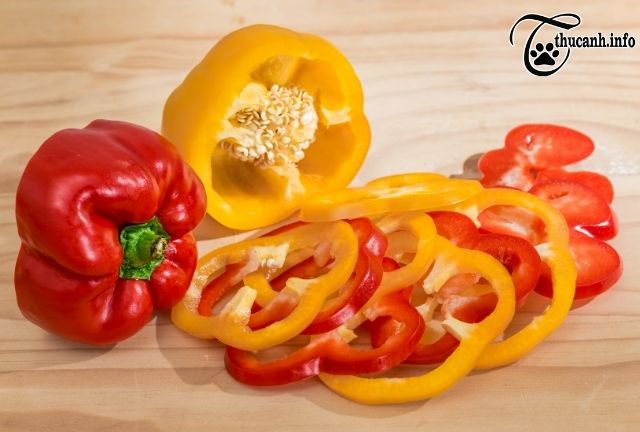Are you wondering if it’s safe to feed bell peppers to your beloved hamster? Look no further! In this comprehensive guide, we’ll explore the question “Can hamsters eat bell peppers?” and provide you with all the information you need to make an informed decision about incorporating this crunchy treat into your furry friend’s diet. From the nutritional benefits to the proper serving size and potential risks, we’ve got you covered.
Let’s dive in and ensure your hamster’s health and happiness with bell peppers as a tasty addition to their meals.

Can hamsters eat red bell peppers?
1. Can Hamsters Eat Bell Peppers?
Yes, hamsters can eat bell peppers. Bell peppers are safe for hamsters and can be included as part of their diet. These vibrant vegetables provide a variety of nutrients and can be a tasty and healthy snack option for your furry friend.
2. The Nutritional Benefits of Bell Peppers for Hamsters

Are bell peppers for Hamsters?
Bell peppers offer a range of nutritional benefits that can enhance your hamster’s diet. These vibrant vegetables are packed with essential vitamins, minerals, and antioxidants. Discover how bell peppers can contribute to your hamster’s overall health and well-being.
2.1. Understanding the Dietary Needs of Hamsters
Hamsters have specific dietary needs that must be met to ensure their optimal care. A balanced diet is crucial, and it’s important to understand the nutrients hamsters require. Explore the significance of meeting these dietary requirements and learn how bell peppers can be incorporated into their meals.
2.2. Can Hamsters Eat Bell Peppers?
You might be wondering if bell peppers are safe for your hamster to consume. The good news is, yes, hamsters can eat bell peppers! These colorful vegetables provide a nutritious addition to their diet. Discover the proper way to introduce bell peppers into your hamster’s meals and the potential benefits they offer.
2.3. Nutrients in Bell Peppers for Hamsters
Bell peppers are rich in various nutrients that can positively impact your hamster’s health. From vitamin C to fiber and antioxidants, these vegetables provide a range of essential elements. Explore the specific nutrients found in bell peppers and how they can support your hamster’s well-being.
2.4. Feeding Guidelines and Precautions with Bell Peppers
While bell peppers are safe for hamsters to eat, it’s essential to follow proper feeding guidelines and take necessary precautions. Learn about the appropriate portion sizes, preparation methods, and potential risks associated with feeding bell peppers to your hamster. Ensure that you provide a balanced and safe diet for your furry friend.
3. Introducing Bell Peppers into Your Hamster’s Diet
When it comes to incorporating bell peppers into your hamster’s diet, it’s crucial to follow proper guidelines for a smooth transition. Discover the steps to gradually introduce this nutritious vegetable to your hamster’s meals, ensuring their acceptance and enjoyment.
3.1. Properly Preparing Bell Peppers for Hamsters
Preparing bell peppers for your hamster requires attention to detail. Learn how to select the right bell peppers, ensuring they are fresh and free from any pesticides or harmful chemicals.
Discover the correct preparation techniques, including washing the peppers thoroughly and cutting them into small, bite-sized pieces suitable for your hamster’s consumption.
3.2. Serving Size and Frequency
Determining the appropriate serving size and frequency of bell peppers for your hamster is crucial for their overall health. Understand the recommended portion size based on your hamster’s size and age. Learn about the ideal frequency at which bell peppers should be offered to maintain a balanced diet and prevent overfeeding.
4. Potential Risks and Precautions

Hamster eat-bell peppers
When considering feeding bell peppers to your hamster, it’s crucial to be aware of potential risks and take necessary precautions. Some hamsters may have allergies or digestive sensitivities to bell peppers. Learn how to recognize signs of allergies or digestive issues in your hamster and take appropriate measures to ensure their well-being.
5. Can Hamsters Eat Red Bell Peppers?
Red bell peppers are a colorful and nutritious vegetable, but can hamsters safely consume them? Learn about the suitability of red bell peppers in a hamster’s diet. Discover the nutritional value they offer, potential benefits, and any precautions to keep in mind when introducing red bell peppers to your hamster’s meals.
6. Can Dwarf Hamsters Eat Peppers?
Dwarf hamsters have specific dietary requirements that differ from other hamster species. Find out if peppers are a suitable addition to a dwarf hamster’s diet. Explore the nutritional benefits and potential risks associated with feeding peppers to dwarf hamsters. Learn how to introduce and incorporate peppers into their meals while considering their unique needs and preferences.
7. Is Too Much Bell Pepper Harmful to Your Hamster?
Excessive consumption of bell pepper can have negative effects on your hamster’s health. It’s important to be aware of the potential risks associated with overfeeding bell pepper and maintain a balanced diet for your furry friend. Here are some key points to consider:
- Digestive Issues: Feeding your hamster too much bell pepper can lead to digestive problems such as diarrhea or upset stomach. The high fiber content in bell peppers may be difficult for some hamsters to digest in large quantities.
- Nutritional Imbalance: While bell peppers are nutritious, they should be part of a diverse diet. Overfeeding bell peppers can lead to an imbalance in nutrients, as they cannot provide all the necessary vitamins and minerals that hamsters require.
- Water Content: Bell peppers have a high water content, which can cause watery stools if consumed excessively. This can lead to dehydration and electrolyte imbalances in your hamster’s body.
- Obesity and Weight Gain: Bell peppers contain natural sugars, and consuming them in excess can contribute to weight gain and obesity in hamsters. Obesity can lead to various health issues and decrease their overall quality of life.
To ensure the well-being of your hamster, it’s essential to offer bell peppers in moderation and as part of a balanced diet. Consult with a veterinarian or do further research to determine the appropriate serving size for your specific hamster breed and size. Monitor your hamster’s reactions and adjust the amount accordingly to prevent any adverse effects.
8. How Much Bell Pepper Should Your Hamster Eat?
Determining the appropriate amount of bell pepper to feed your hamster is crucial for their health and well-being. Here are some guidelines to help you determine the right serving size:
- Size and Age: Consider your hamster’s size and age when determining the serving size of bell pepper. Smaller hamsters require smaller portions compared to larger breeds.
- Moderation: Bell peppers should be offered as a treat or occasional addition to their diet, rather than a primary food source. A small piece or slice of bell pepper is generally sufficient.
- Daily Intake: Limit the amount of bell pepper your hamster consumes each day to prevent overfeeding. One to two small pieces of bell pepper, approximately the size of a thumbnail, are usually recommended.
- Observation: Monitor your hamster’s eating habits and overall health when introducing bell peppers. If your hamster shows signs of digestive issues or weight gain, consider reducing the amount of bell pepper in their diet.
Remember that every hamster is unique, so it’s important to assess their individual response to bell pepper consumption. Always consult with a veterinarian for personalized advice based on your hamster’s specific needs and dietary requirements.
9. What Are Other Healthy Alternatives to Bell Pepper in a Hamster’s Diet?
While bell peppers can be a nutritious addition to your hamster’s diet, it’s important to offer a variety of foods for optimal health and to prevent boredom. Here are some healthy alternatives to consider:
- Leafy Greens: Dark, leafy greens such as spinach, kale, or romaine lettuce provide essential nutrients and can be given in small amounts. Ensure they are thoroughly washed and cut into appropriate sizes.
- Herbs: Fresh herbs like parsley, cilantro, or basil can add flavor to your hamster’s diet. Offer them in moderation as occasional treats.
- Fruits: Offer small pieces of safe fruits such as apple, pear, or melon as occasional treats. Remember to remove any seeds or pits and avoid feeding citrus fruits.
- Root Vegetables: Carrots and sweet potatoes can be given in small quantities as they are rich in vitamins and minerals. Ensure they are grated or cut into small, manageable pieces.
- Seeds and Grains: Sunflower seeds, pumpkin seeds, or cooked quinoa can provide additional nutrients and enrichment for your hamster. Offer them in moderation to prevent weight gain.
- Commercial Hamster Food: High-quality commercial hamster food should make up the bulk of your hamster’s diet. These specially formulated pellets contain a balanced mix of nutrients necessary for their well-being.
Remember to introduce new foods gradually and monitor your hamster’s response to ensure they tolerate them well. Each hamster has unique preferences and dietary needs, so it’s important to offer a varied and balanced diet to support their overall health.
By considering the potential risks of overfeeding bell pepper, determining the appropriate serving size, and exploring alternative healthy options, you can provide your hamster with a diverse and nutritious diet that promotes their well-being.
10. Conclusion: Bell Peppers as a Healthy Addition to Hamster Diet
In conclusion, bell peppers can be a healthy addition to your hamster’s diet when offered in moderation and with consideration for their individual needs. While they provide valuable nutrients and flavors, it’s essential to be mindful of potential allergies or sensitivities.
By providing a variety of safe and nutritious food options, you can ensure a well-rounded diet for your hamster’s overall health and happiness.
Source: THUCANH


